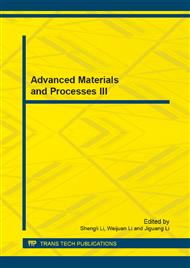[1]
Faguang Leng, Naiqian Feng. State of study and application of phosphate slag [J]. China Building Materials Science & Technology, 1999(3): 43-46. (In Chinese).
Google Scholar
[2]
Guoming Kuang. The present status of domestic phosphorus industry and its sustainable development direction[J]. Phosphate & Compound Fertilizer, 2005, 20(2): 45-47. (in chinese).
Google Scholar
[3]
Jishan Chen. Prospects for the phosphorus industry in China[J]. Phosphate & Compound Fertilizer, 2002, 17(5): 43-46. (in chinese).
Google Scholar
[4]
Dongmei Liu, Kunhe Fang, Fengyan Wu. Research on Development and Utilization of Phosphor Slags[J]. Express Information of Mining Industry, 2005(3): 21-25. (in chinese).
Google Scholar
[5]
Xincheng Li, Yong Liu, Zhangjian Li, et al. Application of double mixture technique about phosphorous slag and expansive admixture in the lgrge volume concrete[J]. Chinal Concrete and Cement Products, 2002, (4): 19-21. (in chinese).
Google Scholar
[6]
Yuqiang Lin, Dingming Guo, Shaochen Guo, et al. Research and application of Phosphorous Slag Powder in Rolled Concrete for Shatuo Hydroelectric Station[J]. Guizhou Water Power, 2012, 26(1): 67-70. (in chinese).
Google Scholar
[7]
Junyu He. Phosphorous slag powder of concrete construction technology[J]. Concrete, 2011, (9): 121-124. (in chinese).
Google Scholar
[8]
Shirong Liu, Jinkai Xiao. The compositional characteristics of Guizhou yellow phosphorous slag[J]. Acta Mineralogica Sinica, 1997, 17(3): 329-336. (in chinese).
Google Scholar
[9]
Dongmei Liu, Kunhe Fang, Huashan Yang. Effect of phosphorus slag ddditive on cement hydration property[J]. Cement Engineering, 2007(2): 74-77. (in chinese).
Google Scholar
[10]
Hongxia Zhai, Shaofeng Liao. Research on hydrated reaction mechanism of phosphorus slag Portland cement[J]. Journal of Hefei University of Technology (Natural Science), 1998, 21(2): 132-136. (in chinese).
Google Scholar
[11]
Caijun Shi. The ivestigation of hydraulic activated phosphorus slag [D]. Materials Science and Engineering of Nanjing Institute, 1987. (in chinese).
Google Scholar
[12]
Xia Chen, Junxin Yi, Li Zeng. Experiment on the mechanical activation of phosphorus slag and the analysis involved[J]. Fly Ash Comprehensive Utilization, 2006, (4): 16-18. (in chinese).
Google Scholar
[13]
Shaodong Wang. Hydration features of new phosphorous slag cement[J]. Journal of The Chinese Ceramic Society, 1990, 18(4): 379–384. (in chinese).
Google Scholar
[14]
Caijun Shi. Alkali-activated cements and concretes[M]. Beijing, Chemical Industry Press, 2008. (in chinese).
Google Scholar
[15]
Lin Chen, Guanghong Sheng, Yanling Pi. Influence of phosphorous slag on the setting time of portland cement and its mechanism analysis[J]. Journal of Nanjing University of Technology, 2004, 26(5): 5-8. (in chinese).
Google Scholar
[16]
Dongxu Li, Jinlin Shen, Yujiang Wang, et al. Influence of admixtures on microstructure of glass state cementing materials containing small amount of calcium[J]. Journal of Nanjing University of Chemical Technology, 2000, 22(1): 46-50. (in chinese).
Google Scholar
[17]
written by P. Metha. translated by Yongnian Zhu, Wei Sheng, Zhiyuan Chen. Concrete: Microstructure, Properties, and Materials[M]. Shanghai, Tongji University press, 1991. (in chinese).
Google Scholar
[18]
Dongmei Liu, Kunhe Fang, Yan Shi. Influence of phosphate slag on hydration properties and pore structure of cement paste [J]. Journal of the Chinese Ceramic Society, 2007, 35(1) : 109-113. (In Chinese).
Google Scholar
[19]
Gao Peiwei, Lu Xiaolin, Yang Chuanxi, et al. Microstructure and pore structure of concrete mixed with superfine phosphorous slag and superplasticizer [J]. Construction and Building Materials, 2008(22): 837-840.
DOI: 10.1016/j.conbuildmat.2006.12.015
Google Scholar
[20]
Li Dongxu, Shen Jinlin, Mao Liangxi, et al. The influence of admixtures on the properties of phosphorous slag cement[J]. Cement and Concrete Research, 2000(30): 1169-1173.
DOI: 10.1016/s0008-8846(00)00291-x
Google Scholar
[21]
Li Dongxu, Shen Jinlin, Chen Lin, et al. The influence of fast-setting/early -strength agent on high phosphorous slag content cement[J]. Cement and Concrete Research, 2001(31): 19-24.
DOI: 10.1016/s0008-8846(00)00442-7
Google Scholar
[22]
Xia Chen, Kunhe Fang, Li Zeng. The optimal theoretical content of phosphorus slag powder in cement-based materials[J]. Bulletin of the Chinese Ceramic Society, 2009, 28(1): 1-5. (In Chinese).
Google Scholar
[23]
Keren Zheng, Wei Sun, Yantao Jia, et al. Effects of slag dosage on hydration products and pore structure of cement paste at high water to binder ratio[J]. Journal of The Chinese Ceramic Society, 2005, 33(4): 520-524. (In Chinese).
Google Scholar


